Hickok Tube testers
About Hickok testers.
You must be interested in a Hickok tube tester :) These are indeed excellent devices. Made by and for people who know what they want. There are many models made, some meeting a TV service man's requirements for speed and simplicity, some for the military which can be operated by anyone quickly, some are intended for a budget lab, even with a multi meter build im (yes!), some for the "better" labs, and some card programmable testers. You name it, Hickok had it. If you have not chosen a model yet, be aware for what specific purpose a testers was intended for. These are however not suited for an amateur who wants to become a tube doctor. If you are planning this career for yourself, get yourself digital tester. But, before you go to the advanced, "self learning" way, do not try to skip basics. So you want to learn how to fly a 40 seats, double jet engine airplane? Then you need to learn how to fly a one propeller little airplane first. For the same reason it it is recommended to learn basic behavior of tubes, first with a good old vintage tester. This will give you the required feeling for why sometimes tubes work fine in equipment, where you did not expect it, and vice versa as well. Specially this matter is only addressed by good vintage products. You will learn to appreciate the judgement of a good Hickok. Though most of them do give a transconductance number as "result" , this number is of little use by itself, for two reasons. First, because it is tested under totally none data sheet conditions. So it can only be compared to the roll chart (expected result), and if you do that, you get an amazingly reliable answer to the main question you have: Is the tube good, or bad. Second, because even if you would know the transconductance under correct data sheet conditions, you know still nothing, because no data sheet tells you what is a good or a bad number. So getting a reliable good-bad answer from a tube tester, it's what they were made for. The pure military TV7 version does not even give transconductance. The soldier in question doesn't care at all about this. Why should he? He only wants to know of the tube is good or not.
So on this light you have to see the Hickoks. They are definitely no "simple" machines however. The work very intelligent at the inside, hardly any technical issues, and the smaller ones or larger ones, are adapted to the user's needs. Most of all, they give you a reliable test result.
Repair of a Hickok. This is NOT EASY. Because inside is only cable salad, and extremely difficult working switches. You will hardly be able to follow a wire, the circuit has no "ground" as you would be used to. Rather everything inter acts with something else, and service documentation is hard to find. But, when everything works, they work fine, and need no maintenance. That is why I say, if this is your first Hickok, leave your fingers off one which is not said to be good condition.
General features
Micromho (=ma/V) readings, by means of a patented Hickok two-tube circuit which you will find in all testers with some variations. Some of the later solid state testers had the same circuit. Because of this 'standard' circuit, each tester is a good one. Future Tube life indication. The 'English' reading with most of the testers. Some Laboratory models have additional tests. Case is rugged and large, leaving us today plenty of room for upgrades Wooden case is extremely rugged. Deck plate is nicely engraved and solid. Gas Test. This is done with a standard test circuit, by putting a very high series resistor in the grid. The idea is, that tube gas gives grid current, and this will generate a small voltage over this resistor. The small voltage will add to the DC bias voltage, and change the bias of the tube. This change has always it's limits no matter what causes it. So regardless if it is gas if leakage, we always call it 'gas' when you have a Hickok. Noise test. This seem a nice method, though I must admit never tried it. You have to connect am AM radio receiver antenna to the noise test output, and if there is any noise, this will give loud crack sounds on the radio.
Not a feature of all Hickok testers:
Electrical safety. The deck plate is not grounded. This has advantages and disadvantages. Better would be if it was not made of metal. Show plate current. Test at standard conditions for a specific tube Test dual tubes with just the flip of one switch.
Micromho and English Test
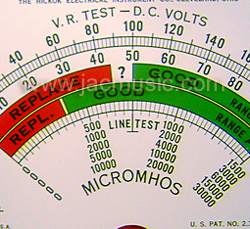
Somebody invented the unit 'Mho' as a reverse value of 'Ohm'. As if that was something useful and needed. That by itself makes me feel funny about it. In Europe they didn't want the word Mho, but for applications where it was needed,. they called it "Siemens". But in fact nobody needed it.
The ridiculous thing is now that we can call a resistor of 10 Ohms also 0.1Mho or 0.1 Siemens. The idea was, to describe the "conductivity". (conductivity is the opposite of resistance) But actually all passive components have only resistance in my healthy opinion. Now, tubes are of course active components. The output current is regulated by the input voltage. So these try to conduct. Their behavior is best written down as milliampere per Volt. Because that is what they are doing. So you change the grid voltage 1Volt, and the output current changes 5mA, and we say the tube has 5mA per Volt. (5 mA/V). That is something I can understand. But when I read a tube can do 5000 micromho, I think huh? Really? What is that? .
Anyway, this explains why USA testers have micromho on it, and many USA datasheets too, whereas European testers always use mA/V. To make it a bit more confusing, generally but not always, the Micromhos are called transconductance and abbreviated as 'Gm' and the mA/V are called 'S' for Siemens. So far for the heritage they left us.
English test
This is another of those things. English test is used by the Hickok testers, and it is a not so good way trying to say you are testing the tube under (an unspecified) load condition. The AVO company in the UK probably made the best recognized series of testers, that tested the tube under load, However, they specify exactly what load, and you could read that on the meter, and make all settings yourself.. So you could compare that with tube curves and datasheets. Apart from that, they invented this red-green scale, where the good/bad result is derived from the transconductance (datasheet !) values. So very clever, and very straight forward. In the USA that was called 'English' testing. This AVO method was patented, which was a major strike. So Hickok had to patent something else. They patented the 'English' test method, which is the RED-GREEN scale you see on most of their testers. I investigated the test results of know to be good and know to be bad tubes, and my conclusion is, it just derives a good/bad value from the already know Gm value. Same principle as AVO, but they (have to) do it in another way, in a very strange way, and in the end the RESULT is the same as with AVO. Test results: With a socket adapter, I just measured the plate current of the tube, while turning the 'ENGLISH' dial, and guess what.... Nothing changes! Only the needle moves when you turn the English dial. So I can only conclude, this changes the sensitivity of the red-green meter, and nothing else. Still the English test is the most used, since it tells you 'good or bad', and the setting of the English pot meter from the roll chart, is the knowledge of the old tube exerts, put into the tester. Admitted is, the results are very reliable, that's why I keep my Hickoks, no matter what. Some testers like TV7 have only the English test, same as with AVO. Test results: With a socket adapter, I just measured the plate current of the tube, while turning the 'ENGLISH' dial, and guess what.... Nothing changes! Only the needle moves when you turn the English dial. So I can only conclude, this changes the sensitivity of the red-green meter, and nothing else. Still the English test is the most used, since it tells you 'good or bad', and the setting of the English pot meter from the roll chart, is the knowledge of the old tube exerts, stored for ever, inside the tester. Admitted is, the results are very reliable, that's why I probably keep my Hickoks for a while longer. Some testers like TV7 have only the English test.
Hickok 531 (technician model, large case)

This is the same as the I-177, only the 531 is the civil model. It doesn't have the potted transformer, and anti fungus treating of the I-177. It is a very old one, so before you buy it make sure it's not rusty inside. It is a nice tester though when you have a good one, though the general rule applies here, if the case looks rotten, the inside is also. The mains voltage meter you see with this one, is retrofitted. The standard way to adjust the mains is via the main meter.
CONCLUSION: Better buy an I-177 TWO STARS *****
Hickok I-177
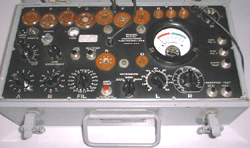
This was my first tube tester. I have two of those. I bought the first one in 1988 for 45 guilders (20 Euro) in the same old electronics shop, where I bought my stuff when I was a kid. He had them piled up. (Radio Kwakkelstein in Vlaardingen). Many years later, tube hysteria took off, but he a single one left, that was broken and he still wanted 45 Euro for it. I took it for spare parts, but never needed any. The thing was made to last for ever, and work without maintenance in the humid and warm countries where the US army was saving the world from communism. So even if you find a stinky old one, it might be good still. It tests all tubes from before the Noval tubes. For later tubes there is an adapter kit, which by itself is a valuable item, since it is a universal socket adapter for any tube tester, not just I-177 and not just Hickok. The I-177 is a really fantastic tester, because it gives remarkably reliable results on the good/bad scale. What is also great, it has only two knobs to choose tubes. Instead of nine (!) with the later models. They all need a calibration badly, if never done before. If this tester says the tube is 'just ok' you can bet it that is just what it is. Most of all you get used to the reading when you test the same kind of tubes, and if you see a tube which is into as good as the other, you better throw that tube away. ( or sell it on Ebay (ahem....) Basically this is THE Hickok tester for the pre-noval tubes. The later model was the TV7 , which could do also test Noval tubes. The I-177 has an interesting way it operates, and this is worth a few lines here. They use their famous patented Hickok circuit, but in the I-177 they added a potentiometer which does noting else then change the meter sensitivity. The signal going to the meter has to pass an attenuator potentiometer. This is the 'L' potentiometer. The result of that is, you can test any tube at all, and have a correct reading on the good/bad scale when you know the setting of that attenuator potentiometer. (Of course they knew that at Hickok, and this is the 'L' value in the handbook). Since the good/bad readings are done by measuring true, dynamic Gm, there is also this particular position of that potentiometer where the Gm (micro mho) scale is valid. This position is marked with 'gm' on the L Pot scale. So the good/bad reading and micro mho reading is done with the same circuit. Their patented Gm measuring circuit is the best of it's kind as far as I know. Due to this patent all other manufacturers had to work without it. It tests all known rectifiers. Also the big triodes like 300B can be tested, and as we know there are not many tube testers that can handle this tube. Not even all later model Hickoks can do a 300B. By experimenting with the settings I can now measure many unlisted tubes with it, like C3g and EM34. It's really a very nice tester, very much recommended. The circuit diagram is inside the tester on a plastic plate. (Fungus proof....), and an Excel list with all test data I found in the internet. These will all work in 100 years from now. They used to be cheap, and regardless useless. Some start to understand how good they are, and prices of those went up a lot over the last years. The bargain days are over, a good tube tester is expensive no matter what. I think these are still a good buy for the money. Here is how to find out settings for an large size tube, like KT88 or so. Find a tube with similar pin out. (that always exists) Set the L pot to the middle position and Gm Sensitivity to 15.000 Set the Bias (R) pot for highest reading. Now rotate R clockwise, until you read 90% of maximum, and this is the bias setting. May be take a little less when the fuse lamps indicates a lot of current, and you think this is too much. The calibration comes in the next step. Find the right Gm Sensitivity knob setting, so that the meter is nicely in the green. (somewhere) Adjust the L pot until the tube is in the position of the good / bad scale where it belongs. So that is just in the green for a fairly used, 'just ok' tube. Now L + R + Sensitivity is a set of information that you must use in that combination. This is a relatively high bias, which is hardest for the tube. I verified some Hickok settings, this is how they seem to do it. And that's it. Here is the KT88 setting I found that way.
A=8 B=5 Fil=6.3 L=70 R=42, Socket E, Gm switch at 6000. I have not yet tried this for small tubes, like ECC83, but there was no need also. The manual was complete so far.

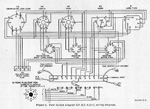
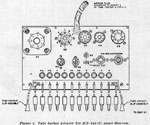
t
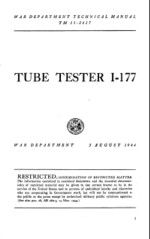
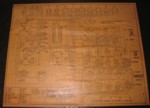 Tester settings for all tubes
Tester settings for all tubes CONCLUSION: The best of this tester is the good/bad test. It discovers any potentially weak tube. Good buy when you use pre-war tubes. It can give the real Gm value of the tubes, and good/bad indication. It has no sockets for modern tubes. Use the MX949 adapter kit, and you can test any modern tube also. Make sure when you buy the adapter kit, you have the extended manual with it, otherwise you only have the adapter kit, but not the settings for it. They are all extremely out of calibration, so that needs to be done for 100% sure, unless the seller did it already for you. (I am sorry, we do not offer calibration service). THREE STARS *****
Hickok 533A, 533B (technician model, large case)

Hickok 534A, 534B (technician model, large case)
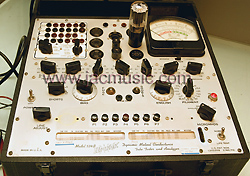
The 534 is a 533 with a build-in multi meter. It is the part you see on the top left. Only for nostalgia freaks, it's too old fashioned multi meter, it has no switches, so you need to plug in cables in the right banana jacks. But it works.
For all other information, refer to the 533, also for the issue with the test signal voltage. (So 534B is much preferred over 543A ) . More information here
Four STARS ****
Hickok TV7 (technician model, small case)

This one came after the I-177, reminds me a bit of the 600. It has very few sockets. No direct reading of Gm in micromho. It has very straight forward way of operating it. What is nice, is the test switch and the short-circuit switch are combined, so you go automatically through the short test, before doing functional testing. Very popular tester. Switches inside are ceramic. Very good service documentation exists still today, and it has nicely arranged calibration settings inside. So if you only want to do a good/bad test without knowing what or why, this is your tester.
Hickok 600 and 600A (technician model, small case)
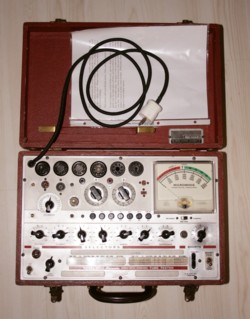
FOUR STARS ****
2) Press Line test, adjust
3) Read tube test result. Here for 12AT7 EHX new tube. This is a strong one.
Hickok 605A. This is the same as the 600, only the 605A has a multi meter inside
Hickok 539A, 539B, 539C (laboratory model)
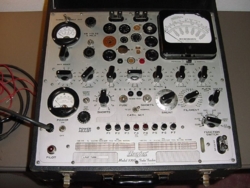
The largest laboratory testers. These are laboratry testers. You can adjust the grid voltage, and then you get the Micromho value, which you compare to the the roll chart.
I purchased this 539A from Mr. E. Dekker from Belgium. This is is how he offered it on Ebay: 'This tube tester is fully operational, all controls and roll chart work smoothly. The outside black Tolex covering does have nicks and tears but this can easily be recovered. All three meters are fully functional with smooth movement'
Unfortunally, the readings are too low. So not as he sais. The case needs new Tolex covering. This material can still be bought.
Hickok 750
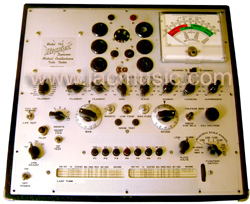
( I know it was done like this from the book of Harvey 'Gizmo' Rosenberg, who described the work of Julius Futterman. Before the war, Julius used to work for a company building tube testers, and tube manufacturers would send him all kind of tubes, to update the roll charts)
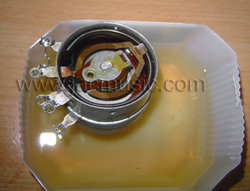
WHAT CAN BE DONE WITH THE 750 AND WHAT IS NOT IN THE MANUAL:
2) Forward voltage of rectifier tubes. This is of particular use in the laboratory If you don't know much about tubes, and only want a quick result, you should use the classical test a by the roll chart.
CONCLUSION: FIVE STARS ****
Hickok . TV2. Military (laboratory model)
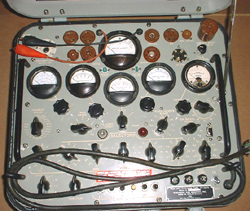
It can test all tubes under real conditions. It comes in the same category as German Neuberger RPG375 tester, though the last is card tester, not switch operated. TV2 is unpopular though, but I never had one here, so I cannot say what is the reason. What is unattractive (for me) about a TV2 is following: It is a tube analyzer, not a tube tester. Now when you have an analyzer, you often want to connect a multi meter to it somewhere, like measure the filament current with a digital meter, or one of the voltages. It often comes down to that when I use the RPG375. So a voltage test point AND a removable current bridge on all tube connections. Particularly THIS is why I use an analyzer like U61B or RPG375. Next thing is, you can set the plate voltage and grid voltage nicely by the data book, and then get a test result called 'Percent Quality'. Whatever that is supposed to be, that is not what to know. When I must set exactly plate voltage, and grid voltage, I am sorry, but then I want to see the plate voltage and Gm as a result, and additional some 'Quality' indication in percent. Still for that I rather have the red-green scale if the 750A or 600A. Then I know what I have. So personally, I think this is what makes TV2 a strange thing. It seems to me people don't know what it's worth, I have seen them go on Ebay in nice condition for 200$. Also see people ask 1800$ for it, which is definitely not what they are worth. When you are prepared to that much, you better buy a guaranteed to be mint condition Neuberger RPG375 or Metrix U61B, and enjoy that tester for the rest of your life. Working on Hickoks means they are easy to access inside, but the wire spaghetti makes you very tired. Actual failures are small, but hard to find. While working on a Neuberger RPG375 is a pleasure. All inside parts are nicely arranged in a row, on metal sub chassis, with clear cabling. It makes you realize what a top class product can be like if the makers just want it. You can repair a Neuberger RPG375 with an uncalibrated multi meter, and basic electronics knowledge. You can't say that from a Hickok. (However, this does not apply for the older Neubergers, these are very hard to service as well. However, the compare here is between the TV2 and the RPG375.
Hickok . MX-1258/U Tube Socket Adapter
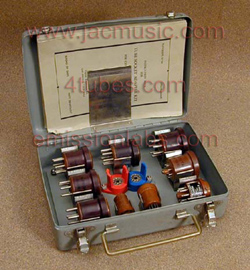


 Hickok known issues, problems and general information
Hickok company photo archive
Hickok known issues, problems and general information
Hickok company photo archive
